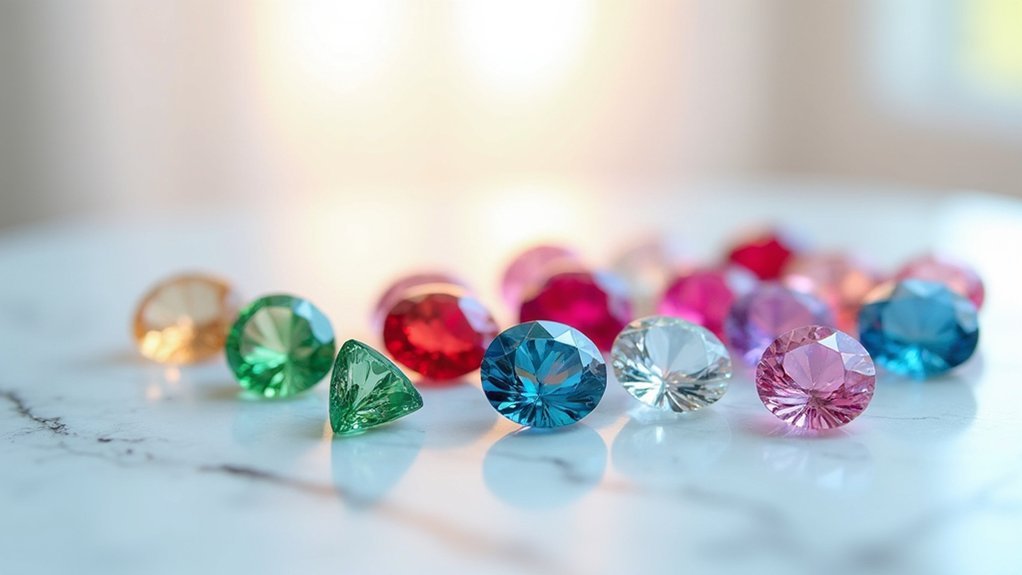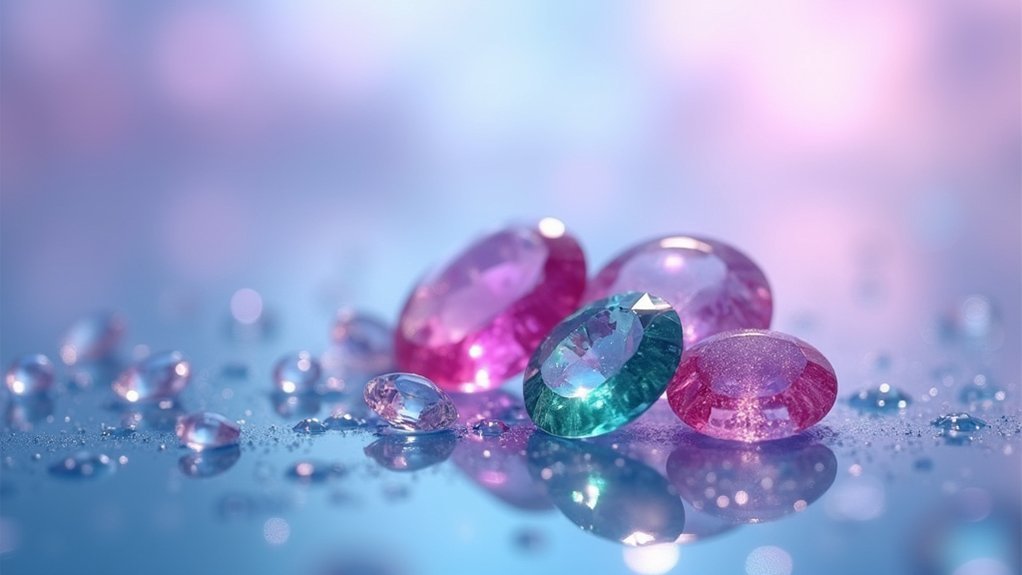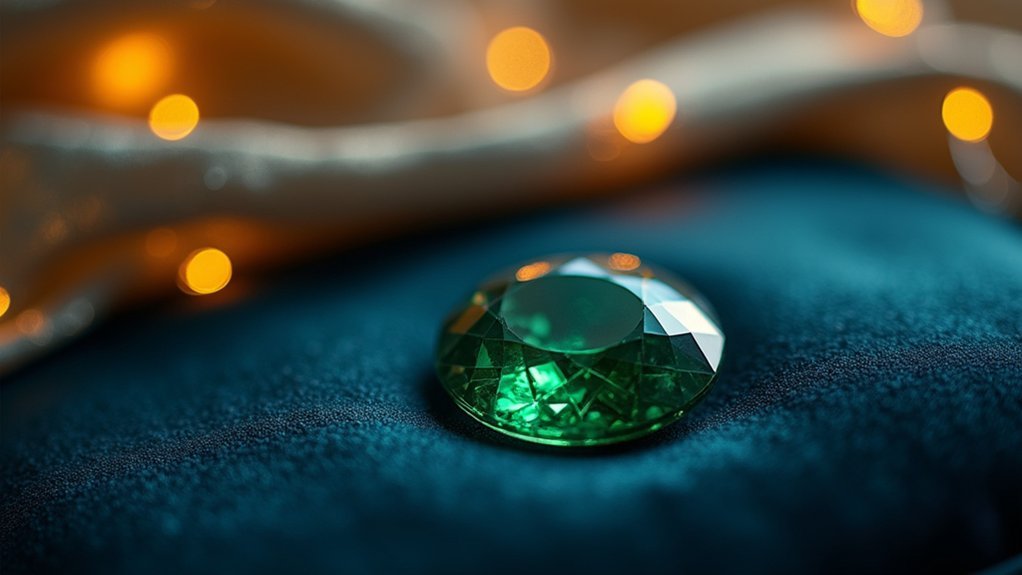You’ll achieve stunning gem photography by choosing the right backdrop that complements your gemstone’s unique characteristics. Classic white backgrounds maximize brilliance and color vibrancy, while dramatic black backdrops create high-contrast images that make gems pop. Neutral gray offers balanced color representation, and gradient backdrops add smooth visual shifts for mood enhancement. Consider textured fabrics like velvet for depth, or reflective mirror surfaces to amplify sparkle. Master these backdrop techniques to reveal your gemstone’s full photographic potential.
Essential Equipment for Professional Gem Photography Backdrops

Five key pieces of equipment form the foundation of professional gem photography backdrops.
You’ll need a large studio light box that guarantees even illumination across your backdrop and gemstones. Various backgrounds including gray, matte, black, and white enhance your jewelry photography while allowing versatile styling options.
A quality studio light box ensures consistent illumination while multiple backdrop colors provide essential versatility for professional gem photography.
A reflector’s essential for redirecting light and reducing shadows, maintaining backdrop quality throughout your shoot.
You can’t overlook a rotating display stand that showcases gems from multiple angles, creating dynamic perspectives against your jewelry backgrounds.
Small Viltrox lights provide additional control over light intensity and tone, helping you achieve desired effects on both backdrop and stones for truly professional jewelry results.
Classic White Backgrounds for Maximum Gem Brilliance
You’ll find that classic white backgrounds offer unmatched versatility for showcasing your gemstones’ natural beauty and intricate details.
The clean, neutral surface eliminates visual distractions while creating a professional appearance that builds buyer confidence.
Let’s explore how you can maximize white background benefits through proper setup techniques and strategic lighting approaches.
White Background Benefits
When photographing gemstones, a classic white background remains the gold standard for showcasing maximum brilliance and clarity.
The white background benefits extend far beyond simple aesthetics – you’ll discover enhanced color vibrancy and crystal-clear detail definition that make your gems truly pop. This smooth, neutral surface eliminates distracting shadows and unwanted reflections that could diminish your stone’s natural beauty.
You’ll appreciate how versatile white backgrounds prove for jewelry display across different gemstone types and marketing platforms. The clean, professional appearance builds buyer confidence while minimizing your photo retouching workload.
When you combine proper lighting techniques with this backdrop choice, you’re creating ideal conditions that amplify your gem’s inherent sparkle and fire, resulting in compelling images that drive sales.
Setup and Lighting
Creating the perfect white background setup requires attention to both surface preparation and strategic lighting placement.
You’ll need a smooth, wrinkle-free white surface like high-quality paper or fabric to eliminate visual distractions. Position your gemstone on this pristine backdrop, guaranteeing no creases or imperfections appear in your frame.
For ideal lighting, use natural light from a large window or diffused artificial sources. This setup minimizes harsh shadows while maximizing the clarity of your gem’s features.
Position lights at 45-degree angles to reduce glare and hot spots.
Adjust your camera to a lower ISO and smaller aperture for maximum depth of field. This combination guarantees your entire gemstone remains sharp against the white backdrop, creating the high-contrast environment that makes colors pop brilliantly.
Dramatic Black Backdrops for High-Contrast Gemstone Images

You’ll need to master specific lighting techniques when shooting gemstones against black backdrops to prevent unwanted reflections and hotspots.
Position your lights at carefully controlled angles to guarantee even illumination across the stone’s surface while maintaining the dramatic contrast that makes black backgrounds so effective.
These lighting strategies will help you achieve that professional, high-contrast look that makes colored gemstones truly pop against the dark backdrop.
Essential Lighting Control Techniques
Although black backdrops can intimidate beginner photographers, they’re actually one of the most forgiving and impactful choices for gemstone photography when you master the lighting fundamentals.
Proper lighting control is essential for achieving dramatic high-contrast images that showcase gemstone details brilliantly.
Start with soft, diffused light sources to minimize harsh reflections and shadows. Position your lights at multiple angles around the gemstone, experimenting with different illumination patterns that emphasize cuts and facets.
Don’t forget to use reflectors strategically—they’ll redirect light precisely where you need it, enhancing brilliance without overwhelming your dark backdrop.
Finally, adjust your camera’s exposure settings carefully. Lower your ISO and set the correct aperture to capture rich colors and intricate details while preserving that striking contrast effect.
Achieving Professional Contrast Effects
Black backdrops transform ordinary gemstone photos into striking professional images that command attention.
You’ll create dramatic contrast that makes jewelry colors pop brilliantly against the dark surface. When capturing stunning gems like an elegant emerald, the black background eliminates distractions and focuses viewers on intricate details.
Control your lighting carefully to prevent unwanted reflections. Soft, diffused illumination works best, creating even coverage without harsh shadows that could obscure your gem’s features.
The high contrast you’ll achieve naturally draws eyes to textures and precise cuts.
Adjust your camera settings strategically—fine-tune aperture and ISO to enhance depth and clarity. This combination of controlled lighting and proper camera configuration guarantees your gemstone photography achieves that coveted professional appearance that showcases high-end pieces effectively.
Neutral Gray Backgrounds for Balanced Color Representation
Photographers seeking the perfect balance between subtlety and impact often turn to neutral gray backgrounds for their gemstone photography.
You’ll find that gray provides soft contrast that complements various gemstone colors without overwhelming your composition. This backdrop minimizes harsh shadows and reflections, delivering balanced representation of your gem’s features.
Gray backgrounds create cohesive, elegant presentations that work beautifully across different types of jewelry.
Gray backgrounds deliver cohesive, elegant presentations that enhance jewelry photography across all styles and types.
Whether you’re capturing delicate rings or bold statement pieces, gray looks good with virtually any jewelry looks you’re showcasing. You’ll want to use soft, diffused lighting to guarantee even illumination and maximum clarity.
The versatility of gray backgrounds makes them incredibly popular among professional photographers.
You can effectively use them across different photographic styles and themes while maintaining consistent, sophisticated results.
Gradient Backdrops for Smooth Visual Transitions

You’ll create enchanting gradient backdrops by blending colors that complement your gemstones without overwhelming their natural beauty.
Focus on establishing smooth color shifts that guide the viewer’s eye toward your gems while adding visual depth to the composition.
Master the lighting techniques needed for gradients to guarantee uniform illumination that enhances your stones’ brilliance without creating distracting shadows or reflections.
Creating Smooth Color Transitions
When you’re seeking to add visual depth without overwhelming your gemstones, gradient backdrops offer the perfect solution for creating smooth color shifts that enhance your composition.
Select complementary colors that shift seamlessly, ensuring they support rather than compete with your stones. Whether you’re photographing on a Crystal Deck or studio surface, soft lighting becomes essential for minimizing harsh shadows and maintaining uniform appearance across color shifts.
You’ll want to carefully adjust backdrop placement during your shoot to maximize the gradient effect and storytelling flexibility.
These smooth shifts can evoke specific moods—cool blues for tranquility, warm oranges for energy—making them ideal for artistic gem photography. The key lies in balancing color intensity with your gemstone’s natural beauty.
Lighting Techniques for Gradients
Proper lighting transforms gradient backdrops from simple color shifts into powerful photographic tools that showcase your gems’ brilliance.
You’ll want to use soft lighting techniques like diffused natural light or softbox lighting to emphasize the gradient effect. These methods minimize harsh shadows and highlights, allowing colors to blend seamlessly without competing with your gemstones.
Position your lighting to maintain consistent exposure across the entire gradient. This guarantees the color shift remains smooth while complementing your gems rather than overwhelming them.
Avoid direct, harsh lighting that creates unwanted reflections or hot spots on your gradient backdrop.
Test different lighting angles and intensities to find the sweet spot where your gradient enhances the gemstone’s natural beauty without creating distracting elements in your composition.
Textured Fabric Backgrounds for Added Visual Interest
While smooth surfaces might seem like the obvious choice, textured fabric backgrounds can transform your gem photography from ordinary to extraordinary.
Velvet, silk, and linen each offer distinct textures that complement your gems while adding depth and visual dimension to your shots.
Textured fabrics like velvet, silk, and linen create stunning depth that makes gems appear more dynamic and visually captivating.
These fabrics excel at absorbing light, which reduces harsh reflections that can overpower your subject. You’ll achieve more balanced, appealing images as a result.
Choose fabric colors and patterns strategically to evoke specific moods and match your jewelry’s style.
The key is selecting colors that contrast with your gems, ensuring they pop against the background rather than blend in. This contrast captures viewers’ attention and makes your gems the undisputed focal point of each photograph.
Reflective Mirror Surfaces for Double Impact Shots

Nothing amplifies a gem’s natural sparkle quite like a reflective mirror surface that creates enchanting double-image effects.
You’ll discover that mirrors double your gem’s visual impact, showcasing intricate details from multiple angles while enhancing overall brilliance. This technique contributes to dynamic compositions, opening creative possibilities that highlight your stone’s unique characteristics.
Position your mirror at strategic angles to manipulate light reflections, adding depth and dimension while minimizing unwanted shadows.
You’ll achieve the best results when your mirror surface remains spotlessly clean and smudge-free, ensuring complete focus stays on your gemstone.
Don’t hesitate to experiment with various mirror sizes and shapes.
Each configuration yields different artistic results, providing you with diverse aesthetic options that’ll transform your gem photography from ordinary to extraordinary.
Natural Stone and Marble Backdrop Options
When you’re seeking backdrops that’ll bring sophistication to your gem photography, natural stone and marble surfaces deliver unmatched elegance through their distinctive textures and organic patterns. These backdrops create striking contrasts that make your gemstones pop, while their subtle veining adds visual depth without competing for attention.
| Stone Type | Best For | Key Advantage |
|---|---|---|
| White Marble | Colored gems | Enhanced contrast |
| Black Granite | Light stones | Dramatic backdrop |
| Travertine | Earth tones | Natural warmth |
You’ll find these surfaces naturally reflect light, boosting your gems’ sparkle and clarity. The varied colors and finishes available let you match different photography styles, from minimalist to luxurious themes, making natural stone backdrops versatile tools for professional-quality shots.
Colored Backgrounds to Complement Specific Gemstones

Color selection transforms gem photography by creating harmonious relationships between your stones and their backgrounds.
You’ll discover that complementary colors can dramatically enhance your gemstone’s natural beauty when chosen thoughtfully. For emeralds, try warm burgundy or deep gold backgrounds that make the green more vibrant. Sapphires shine against copper or orange tones, while rubies pop beautifully on forest green or navy backdrops.
However, you must exercise restraint with colored backgrounds. They can quickly overwhelm delicate gems or distract from intricate details you’re trying to showcase.
When you’re uncertain, start with muted versions of complementary colors rather than bold, saturated hues. Test different combinations during your shoots, as some gemstones respond better to subtle color relationships than dramatic contrasts.
LED Light Boxes for Even Background Illumination
While colored backgrounds create stunning visual relationships, LED light boxes revolutionize how you illuminate those backdrops for consistent, professional results. You’ll achieve uniform illumination that eliminates unwanted shadows and hot spots that plague traditional lighting setups.
| Feature | Benefit | Impact |
|---|---|---|
| Adjustable Brightness | Custom light intensity | Ideal exposure control |
| Diffuser Panels | Softened light output | Enhanced gem appearance |
| Even Distribution | Eliminates shadows | Superior clarity |
| Portable Design | Studio or location use | Maximum versatility |
These light boxes prevent harsh reflections while accurately representing your gemstone’s natural colors and intricate details. You can adjust brightness settings to match specific exposure requirements, ensuring each shot captures the stone’s true beauty. The compact, portable design makes them perfect whether you’re shooting in-studio or need professional lighting on location.
DIY Backdrop Solutions for Budget-Conscious Photographers
Professional lighting equipment like LED light boxes delivers exceptional results, but you can create equally impressive backdrops without breaking your photography budget.
You’ll find poster board, fabric, or wrapping paper works perfectly for customizable backgrounds that match your gemstone’s aesthetic. White or black foam board creates clean, professional looks that enhance clarity without distractions.
For added visual interest, try textured materials like burlap or felt, which showcase colorful stones beautifully. Natural elements such as wood or stone surfaces complement gemstones’ organic nature while creating rustic appeal.
You can also experiment with gradients by painting large canvases with complementary colors, providing smooth shifts that enhance your gem photography’s visual impact. These budget-friendly solutions deliver professional-quality results.
Digital Background Replacement Techniques
Although physical backdrops offer tangible results, digital background replacement opens unlimited creative possibilities for your gem photography.
Digital backgrounds unleash boundless creative potential beyond what traditional physical setups can achieve in gemstone photography.
You’ll achieve seamless integration while maintaining your gem’s pristine details through proper technique.
Adobe Photoshop’s Magic Wand and Layer Masks enable precise background selection without compromising your gemstone’s integrity.
You must use high-resolution digital backgrounds to preserve image sharpness and prevent detail loss during editing.
Here are three essential techniques for successful digital replacement:
- Match lighting and shadows between your gem and new background to create realistic, engaging results.
- Select complementary colors and textures that enhance rather than compete with your gemstone’s natural features.
- Maintain sharp focus on the gem by ensuring it remains the clear focal point against any backdrop.
This approach maximizes creative control while delivering professional results.
Backdrop Maintenance and Storage Best Practices
Whether you choose physical backdrops or digital replacement techniques, your investment requires proper care to deliver consistent results over time.
Store your backdrops rolled or flat in dry, dust-free environments to prevent creases and damage. You’ll maintain their pristine condition for every photography session this way.
Clean backdrops regularly with soft, lint-free cloths to remove dust and fingerprints that compromise visual quality.
Use protective covers or cases for delicate or textured materials during storage and transport to avoid wear and tear.
Don’t expose colored backdrops to direct sunlight for extended periods, as this causes fading and discoloration.
Categorize and label your backdrops by type or color in storage. This organization streamlines access and selection during photography setups, greatly enhancing your workflow efficiency.
Frequently Asked Questions
What Is the Best Lighting for Gemstone Photography?
You’ll achieve best results using soft, diffused lighting with softboxes or natural daylight. Combine warm and cool lights for accurate colors, use light tents to reduce reflections, and add reflective surfaces to enhance brilliance.
What Is the Best Background for Jewelry Photography?
You’ll find white backgrounds work best for jewelry photography since they’re versatile for all marketing channels. However, you should consider black for dramatic gemstone shots or neutral grays for elegant presentations.
What Camera Is Best for Gemstone Photography?
You’ll want the Nikon D3400, Canon EOS Rebel T5, or Nikon D5300 for gemstone photography. These cameras offer excellent image quality and user-friendly features that’ll help you capture stunning, detailed shots of precious stones effectively.
What Kind of Backdrop Is Best for Photography?
You’ll want plain white backgrounds for clarity and detail enhancement. Black creates dramatic contrast that makes colors pop. Grey offers elegant softness, while textured backdrops add visual depth and interest to your shots.
In Summary
You’ve got all the backdrop knowledge needed to elevate your gem photography game. Whether you’re investing in professional equipment or crafting DIY solutions, remember that consistent lighting and proper maintenance will make or break your shots. Don’t be afraid to experiment with different backgrounds until you find what works best for your style. Your gemstone images will shine brighter when you’ve mastered these backdrop fundamentals.





Leave a Reply